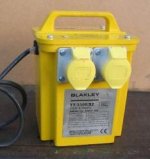A friend was at the manchester Audio show recently & in one room came accross an exhibitor running his gear off two step down trafos back to back. In other words 230 to 110V - 110V to 230V.
He claimed this did 99% of what was needed for power conditioning.
Could this be? Would one step down be just as effective?
He claimed this did 99% of what was needed for power conditioning.
Could this be? Would one step down be just as effective?
This forms an isolation transformer. An isolation transformer will stop most common mode noise. High frequency noise attenuation is limited by inter winding capacitance, certain winding techniques can minimize inter winding capacitance.
Because of transformer leakage inductance, a small reduction in metallic (i.e. single ended as opposed to common mode) high frequency noise can also be expected.
Of course any transformer inside the existing electronics has mostly all these same properties, there may be a net improvement, but I'm guessing it's quite small.
This will stop any AC cord ground loops so it may have value there.
Because of transformer leakage inductance, a small reduction in metallic (i.e. single ended as opposed to common mode) high frequency noise can also be expected.
Of course any transformer inside the existing electronics has mostly all these same properties, there may be a net improvement, but I'm guessing it's quite small.
This will stop any AC cord ground loops so it may have value there.
So is one stepdown transformers not an isolation transformer ie primary & secondary & from what you say it would have the same effect as two, as long as the equipment can be run at 110V?
So is there more to power conditioning than this?
Has anyone tried the DIY power conditioners http://myweb.tiscali.co.uk/nuukspot/decdun/powersupplies.html#top6
or Thorsten's similar power conditioner on TNT-audio (can't find the URL)?
So is there more to power conditioning than this?
Has anyone tried the DIY power conditioners http://myweb.tiscali.co.uk/nuukspot/decdun/powersupplies.html#top6
or Thorsten's similar power conditioner on TNT-audio (can't find the URL)?
All transformers isolate (except autoformers). A specialty transformer with the primary equal to the secondary is usually referred to as an isolation transformer.
Power conditioning covers a lot of ground. Some things that various power conditioners do:
1. Transient suppression.
2. Short circuit protection.
3. Isolation.
4. Noise filtering both common mode and/or metallic.
5. Voltage regulation.
6. Complete regeneration of the input power sine wave.
7. Energy storage.
Power conditioning covers a lot of ground. Some things that various power conditioners do:
1. Transient suppression.
2. Short circuit protection.
3. Isolation.
4. Noise filtering both common mode and/or metallic.
5. Voltage regulation.
6. Complete regeneration of the input power sine wave.
7. Energy storage.
Eva said:In Europe almost all the 230V <--> 110V transformers are actually autotransformers so no isolation is provided. Their leakage inductance may do a good filtering job, though, at the expense of some voltage drop.
Salesmen like to make risky claims...
I had an idea that this might be the case here OK 230V -->110V = autotransformers. Does this apply even to the ones used on building sites for power tools? Is there a make which is an isolation trafo? I want to power a 110V amp and would like some conditioning while I'm buying a step-down trafo. I can get a discarded APC UPS from college - for which I have batteries but is it easy to mod to 110V output?
It may have been something a little more subtle.
He may have been using "industrial" step-down transformers as used outdoors on building sites essentially, 55-0-55v
That way, with the mains ground taken to the 'o' tapping, some common mode interference may be reduced.
This has been suggested before. An article appeared some years ago in HiFi World (see this site for the article and a similar balanced supply :- http://home.quicknet.nl/qn/prive/ra.vdsteen/balsource_en.html )
Andy
He may have been using "industrial" step-down transformers as used outdoors on building sites essentially, 55-0-55v
That way, with the mains ground taken to the 'o' tapping, some common mode interference may be reduced.
This has been suggested before. An article appeared some years ago in HiFi World (see this site for the article and a similar balanced supply :- http://home.quicknet.nl/qn/prive/ra.vdsteen/balsource_en.html )
Andy
poynton said:He may have been using "industrial" step-down transformers as used outdoors on building sites essentially, 55-0-55v
That way, with the mains ground taken to the 'o' tapping, some common mode interference may be reduced.
Good Link Andy, thanks
What are these "industrial" step-down transformers called? Are these the ones used for power tools?
jkeny said:
Good Link Andy, thanks
What are these "industrial" step-down transformers called? Are these the ones used for power tools?
Yep, big yellow things sometimes called site transformers usually 3300w
http://cgi.ebay.co.uk/110-VOLT-3-3-...ryZ11704QQssPageNameZWDVWQQrdZ1QQcmdZViewItem
Andy
Attachments
- Status
- This old topic is closed. If you want to reopen this topic, contact a moderator using the "Report Post" button.
- Home
- Amplifiers
- Power Supplies
- Startling Claim
